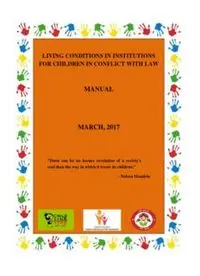
Manual on Living Conditions in Institutions for Children in Conflict with Law PDF
Preview Manual on Living Conditions in Institutions for Children in Conflict with Law
LIVING CONDITIONS IN INSTITUTIONS FOR CHILDREN IN CONFLICT WITH LAW MANUAL MARCH, 2017 “There can be no keener revelation of a society's soul than the way in which it treats its children." - Nelson Mandela Table of Contents MESSAGE................................................................................................................3 FOREWARD..........................................................................................................5 1. ABBREVIATIONS .................................................................................................7 2. INTRODUCTION………………………………………………………………....9 3. DEFINITIONS…………………………………………………………………....13 4. HISTORY OF JUVENILE JUSTICE………………………………………….....18 5. GENERAL PRINCIPLES OF CARE AND PROTECTION OF CHILDREN…..23 6. OVERVIEW OF JUVENILE JUSTICE (CARE AND PROTECTION OF CHILDREN) ACT, 2015.......................…...………………………………….....28 7. CHILD PROTECTION POLICY…………………...…………………………....35 8. CHILDREN‘S PARTICIPATION IN CCI FOR CCL…………………………...49 9. UNDERSTANDING ADOLESCENCE...…………………………………….....58 10. INFRASTRUCTURE AND PHYSICAL FACILITIES IN THE CCI…………..62 11. ROLES & RESPONSIBILITIES OF STAFF…………………………………....74 12. SERVICES FOR CHILDREN IN CONFLICT WITH LAW IN CCI………....107 12.1 Child Care Institutions- Objectives and approach………………………....108 12.2 Receiving a Child in a Child Care Institution (CCI)……………………....114 12.3 Care to be provided in reception unit/dormitory of CCI…………………..117 12.4 Individual case conference………………………………………………....123 12.5 Children‘s participation in governance of CCI through committees……...124 12.6 Daily routine……………………………………………………………….126 12.7 Health care………………………………………………………………....132 12.8 Education of children in CCI……………………………………………....138 12.9 Vocational training and skill development………………………………...141 12.10 Life skills education (LSE)……………………………………………….143 12.11 Physical training (pt), sports, games, recreation, art and craft in CCI…....144 12.12 Safety and security………………………………………………………..148 12.13 Emergency services………………………………………………………151 12.14 Redressal systems………………………………………………………...156 12.15 Family visits and interaction……………………………………………...159 12.16 Transfer, release and after care…………………………………………...162 12.17 Recording and Mantainance of Registers...………………………………169 13. PLACE OF SAFETY……………………………………………………………177 14. MONITORING AND INSPECTION OF CCI………………………………….185 15. ANNEXURES…………………………………………………………………..191 (I) RESTORATIVE JUSTICE...........................................................................192 (II) FORMS FOR CCL AS PER JUVENILE JUSTICE (CARE AND PROTECTION OF CHILDREN) MODEL RULES 2016 ..........................195 16. BIBILIOGRAPHY……………………………………………………………...285 2 3 4 5 6 1. ABBREVIATIONS 7 Abbreviations Board/JJB Juvenile Justice Board CCI Child Care Institution CCL Child in conflict with law CPP Child Protection Policy CWC Child Welfare Committee CWO Child Welfare Officer CWPO Child Welfare Police Officer DCPO District Child Protection Officer DCPU District Child Protection Unit ICP Individual Care Plan ICPS Integrated Child Protection Scheme ITI Industrial Training Institute IQ Intelligence Quotient JJA/JJ Juvenile Justice (Care and Protection of Children) Act, 2015 Act,2015 JJ Model Juvenile Justice (Care and Protection of Children) Model Rules, 2016 Rules , 2016 NGO Non Government Organization NIOS National Institute of Open Schooling NSDC National Skill Development Corporation OH Observation Home POCSO Protection of Children from Sexual Offences Act, 2012 PO Probation Officer SH Special Home 8 2. INTRODUCTION 9 Introduction India is committed to safeguarding the rights of its children. The Constitution of India through various key provisions recognizes the vulnerabilities faced by children and upholds their right to protection. Article 15 (3) of the Constitution guarantees special attention to children through necessary and special laws and policies that safeguard their rights. The Right to equality, protection of life and personal liberty and the right against exploitation is enshrined in Articles 14, 15, 16, 17, 21, 23 and 24. The spirit of the State towards safeguarding its children is reflected in the key legislations for the protection of children i.e. Juvenile Justice (Care and Protection of Children) Act, 2015, Child Labour (Prohibition and Regulation) Act, 1986 (Amended in 2016), Right to Education Act, 2009 (Amended in 2012), and Prevention of Children from Sexual Offences Act, 2012 etc. Child rights and welfare concerns have also been addressed in a number of International Conventions and norms on child protection including the UN Convention on the Rights of the Child (UNCRC) 1989, the UN Standard Minimum Rules for the Administration of Juvenile Justice (The Beijing Rules), 1985, the UN Rules for the Protection of Juveniles Deprived of their Liberty, 1990, and the Hague Convention on Inter-country Adoption, 1993. The Government of India ratified the UN Convention on the Rights of the Child (UNCRC) in 1992. The Juvenile Justice (Care and Protection of Children) Act, 2015 is the key legislation for juvenile justice in India. The Act emphasizes the rehabilitation and reintegration of children through various non-institutional and institutional measures. The Act recognizes the role of family care and support in the development of children and prescribes various measures for non-institutional care for children in difficult circumstances. It also provides a procedure for trial of children in conflict with law and the orders that can be passed by Juvenile Justice Board in case of children who are found guilty of commission of offence. Such children are either lodged in Observation Home, Special Home or Place of Safety under the said Act. The major change in the 2015 Act is the segregation of children who have perpetrated heinous crimes. The Act vests the JJB with discretion to decide whether a child between 16-18 years accused of committing a heinous crime is to be tried in the adult criminal justice system as opposed to the juvenile justice system. The Hon‘ble Supreme Court of India, in the matter of Re-inhuman conditions in 1382 prisons, (W.P. No.406 of 2013) observed and passed an order on 05.02.2016 to the following effect: ―Taking a cue from the efforts of the Ministry of Home Affairs in preparing the Model Prison Manual, it appears advisable and necessary to ensure that a similar manual is 10
